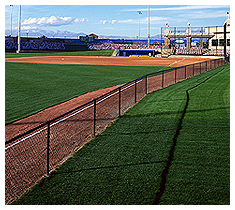Ball Park Blend Turfgrass in California
A versatile turfgrass for a variety of uses
This versatile blend of turfgrass species will adapt to a variety of uses and lawn maintenance regimens. We start with a healthy stand of warm-season Hybrid Bermuda and overseed with a blend of cool-season Ryegrass and Kentucky Bluegrass. The Hybrid Bermuda tolerates heavy traffic and high temperatures. The Ryegrass and Kentucky Bluegrass tolerate shade and offer winter color. All three varieties in our Ballpark Mix have a fine leaf texture.
General Rating
- Drought Tolerance
- Disease Resistance
- Wear Resistance
- Shade Tolerance
- Winter Color
- Heat Tolerance
Available at these farms
Nuevo, CA
Palmdale, CA
Maintenance Guide
Technical Data
Technical Data |
|
|
Common Name |
Ball Park |
|
Species |
Cynodon dactylon – Hybrid Bermuda (Tifgreen |
|
Growth Rate |
Summer 1/2 to 1 1/4 inches per week |
|
Root Depth |
2 to 5 feet, depending upon soil type and watering patterns. |
Adaptability |
|
|
Soils Range |
Fair tolerance to saline soil conditions. |
|
Temperature Tolerance |
10°F. to 110°F. |
|
ET0 |
.5 minimum, .8 preferred |
|
pH Range |
5.0 to 8.5, 7.0 optimum |
|
Shade Tolerance |
Prefers full sun, but adapts to 50% shade. |
|
Geographic Range |
(Refer to temperature tolerance above.) |
Standards and Measures |
|
|
Size |
8 to 10 sq. ft. per piece, depending upon market |
|
Big Rolls |
200 to 500 sq. ft. |
|
Soil Thickness |
1/2 inch , + top growth |
|
Weight |
2,500 to 3,000 lbs. per pallet |
|
Other |
– 100% Weed Free Sod |
Ready to order? Have a few questions?
Contact the farm nearest you.
Moreno Valley, CA
800-233-5254
Palmdale, CA
800-669-4763
Fresno, CA
888-800-8483
Stockton, CA
800-588-6882
Fort Collins, CO
970-482-6574
